KNSM - M.S.
Colombia 1930 to 1943
Please Note: Firefox and some other Search Engines may not be suitable
Use Google Chrome for this Web Page to load perfectly!

Please Note:
All ssMaritime and other related maritime sites are 100% non-commercial and
privately owned, thus ssmaritime is NOT associated with any shipping company or
any other organisation! Although the author has worked and been involved in the
passenger shipping industry for well over 60 years, but due to his old age and
poor health, he was forced to retire. Yet, he has completed well over 1,355
Classic Liners, Passenger-Cargo Liners as well as humble converted C3 converted
Migrant Liners, which has transported countless thousands folk to the new
world, as well on vacations’. I trust the features online will continue
to provide Classic Liner and Ship enthusiasts both the information they are
seeking, but more so provide a great deal of pleasure and relive many happy
memories!
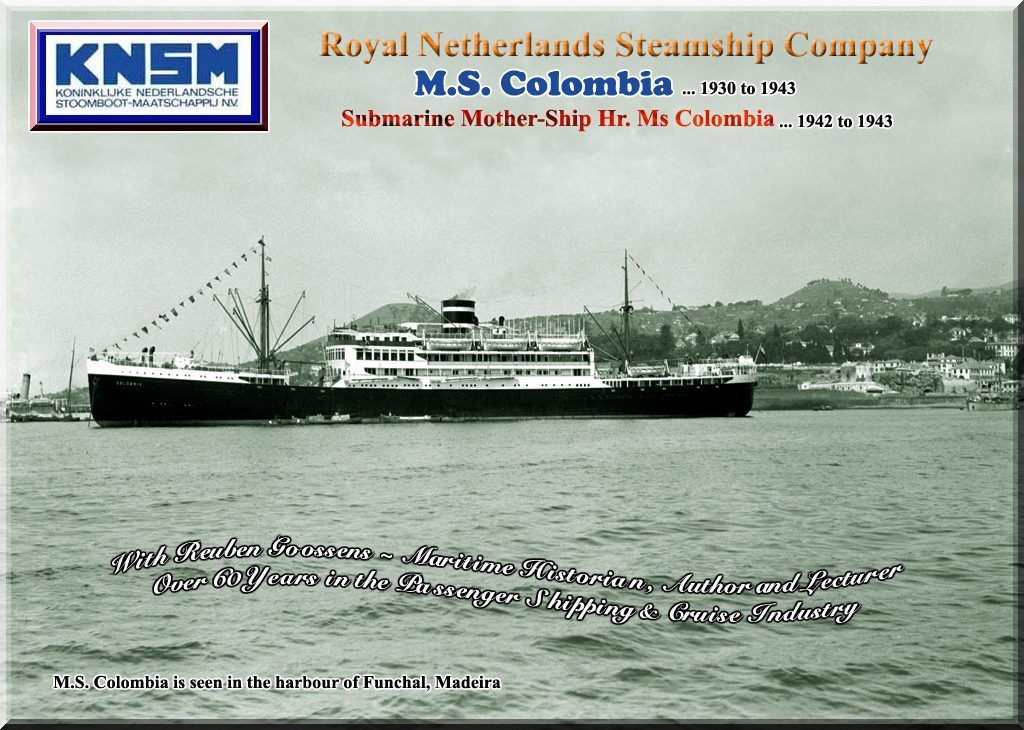
Please
Note: Postcards, photographs & other images
are from the author’s private collection, unless stated otherwise.
A special thank you to Bertus
van
der Molen
and Jeroen
Bouwman
for their images and other assistance.
At the
bottom of the page is a link to a 14.21 min colourised film on YouTube of
the delightful
M.S. Colombia sailing from Amsterdam
to Tilbury, simply amazing!
Building,
Launch and Maiden Voyage:
Welcome to the M.S. Colombia feature of the
intimate 10,782 GRT (Gross Registered Ton) ship that was the luxurious flagship
of the Royal Netherlands Steamship Company (KNSM).
KNSM ordered her to be built by the “P.
Smit
Jr”
Shipyards in Rotterdam
on April 16, 1929, and her keel was laid down in yard N° 454 very early in
1930. On May 24, 1930, she was named “Colombia”
and launched by Mrs. M.E. Giljam-Irens, and as soon she was in the water a tug
towed her to the “P Smit Jr” fit-out berth where she would be
completed.
The M.S. Colombia was completed and headed out
for her deep sea trials on October 1, 1930 and she reached a respectable speed
of 15.5 knots. She was delivered to KNSM on October 22, and having been fully
manned, and stocked up, she finally departed on her maiden voyage on November
28, 1930.
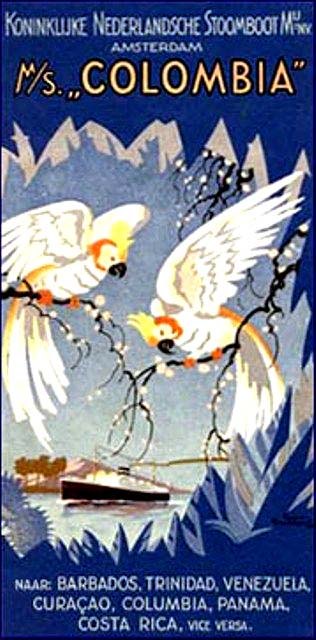
An early M.S.
Colombia promotional poster, although the ship image was rather overdone
Service
and Facilities:
The Colombia
was operated by KNSM as a mail, cargo and passenger liner operating between Amsterdam
and the Caribbean and the USA.
Her schedule was as follows:
Departing from Amsterdam and sailing via Dover
(UK) to Funchal (Madeira), Paramaribo (Suriname), Demerara (Guyana), Trinidad
(Jamaica), then 5 Venezuelan ports, being Carupano, Guanta, La Guaira, Maracaibo,
Puerto Cabello, next to Oranjestad (Aruba), Willemstad (Curacao),
Port-au-Prince (Haiti), then to New York (USA). This voyage usually took 28
days. Her return voyage to Amsterdam
was the above in reverse.
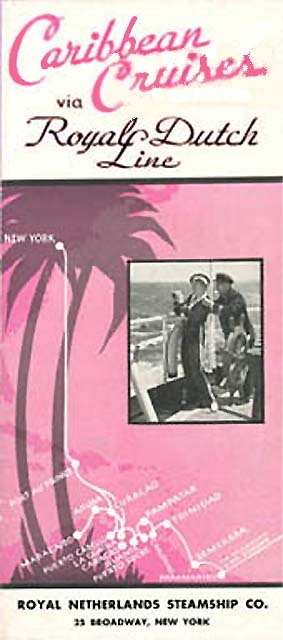
KNSM Brochure and
schedule October 1935 to May 1936
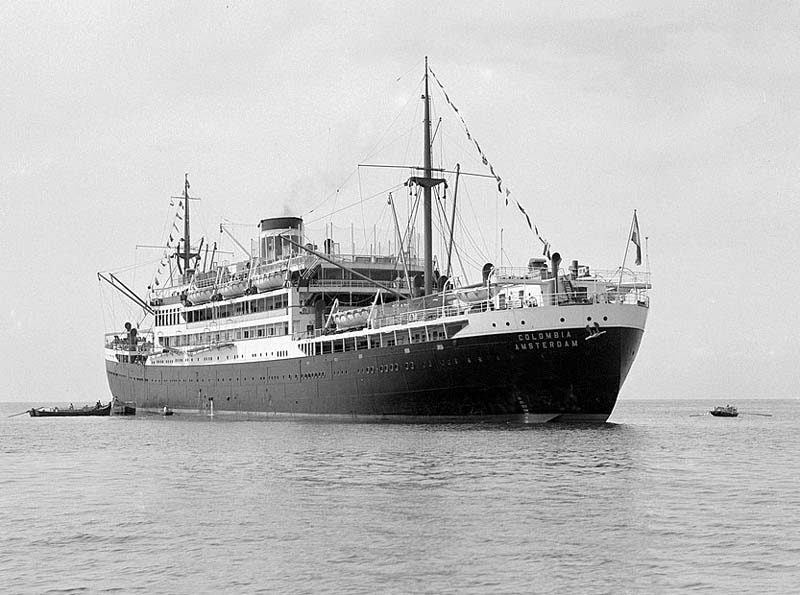
A fine stern view
of the Colombia
However, she also operated luxury
cruises to Norway
and Iceland. There
was no doubt, that she was a most luxurious ship for those days as both First
and Second Class was of a very high standard, and for her Trans-Atlantic
voyages her Third Class was mostly designed for the migrant service, but these
accommodations and public venues were of a high standard. The ship even had a
magnificent indoor swimming pool, as well as an elevator (lift) and
accommodations for 312 passengers. The reason for her interior grandeur
was due to her famous designer, being “C.A. Lion Cachet” who
worked on many of the finest grand Dutch liners over the years.
The M.S. Colombia was especially built to
operate a service from Amsterdam
sailing via Dover
to Madeira, Paramaribo,
Demarara, Trinidad, Carupano, Guanta, La Guaira, Maracaibo,
Aruba, Curacao, Puerto
Cabello
and Port-au-Prince,
then to New
York
taking some 28 days. Her return to Amsterdam
was in reverse.
She operated for 10 years and 19 days
as a full time passenger liner, but World War II would change her role
dramatically as well her long term future, and sadly all this is part of her
history which she has become famous for!
M.S. Colombia Photo Album:
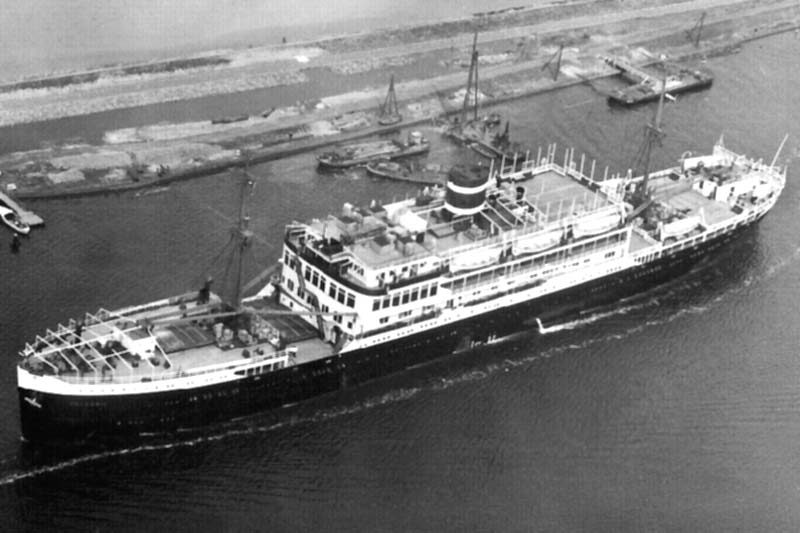
An excellent
aerial view of the M.S. Colombia, showing her four holds and open decks
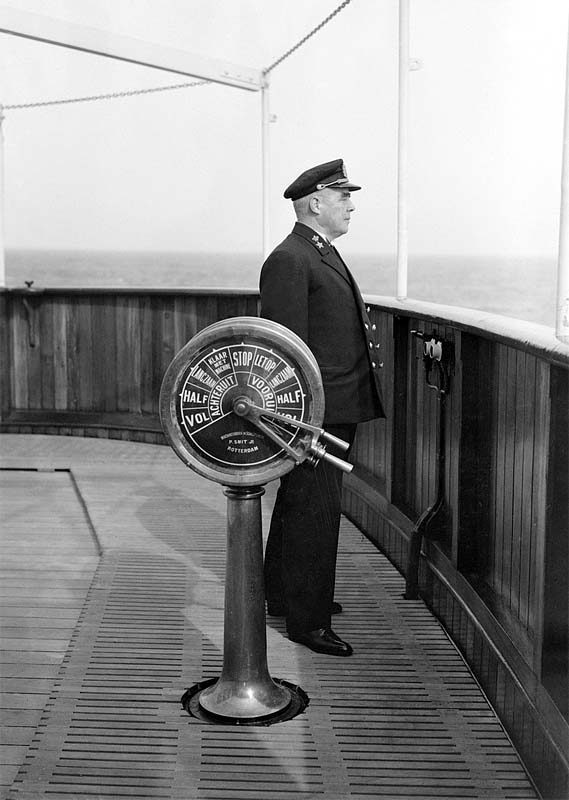 -
-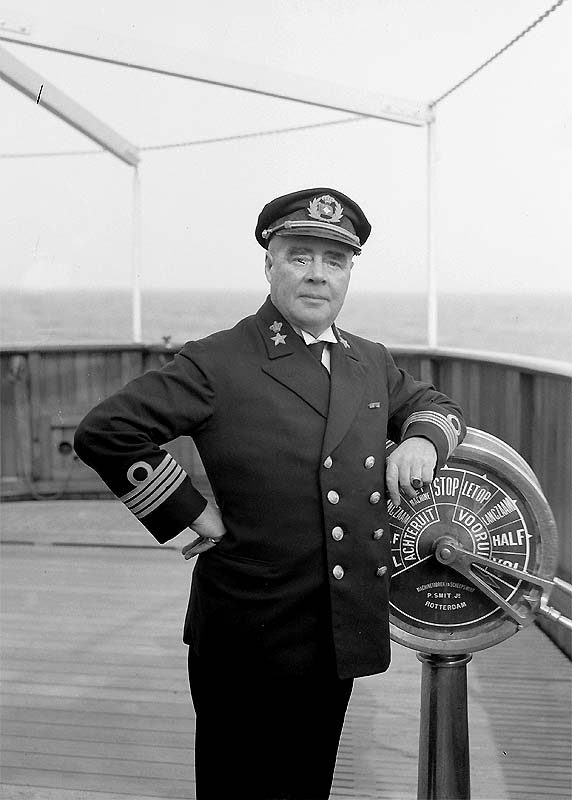
The very popular and long serving captain on the M.S.
Colombia
was Captain
Daniel
Klok,
who served from 1930 to 1938
First Class
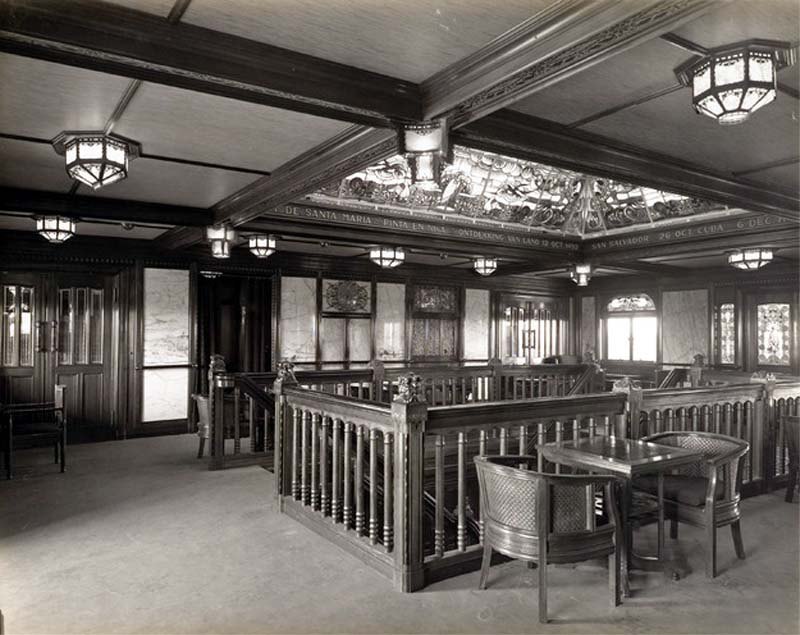
C Deck Lobby with
a magnificent lead glass dome,
Looking forward to the Lounge
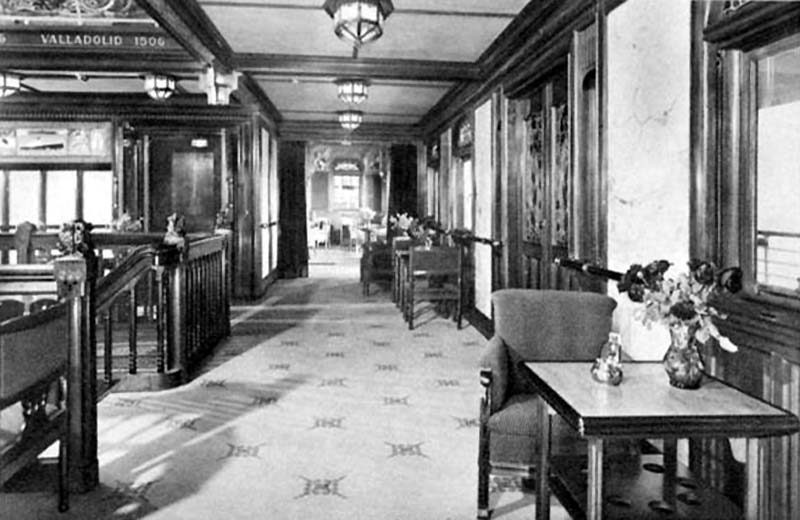
Another Lobby on B
Deck
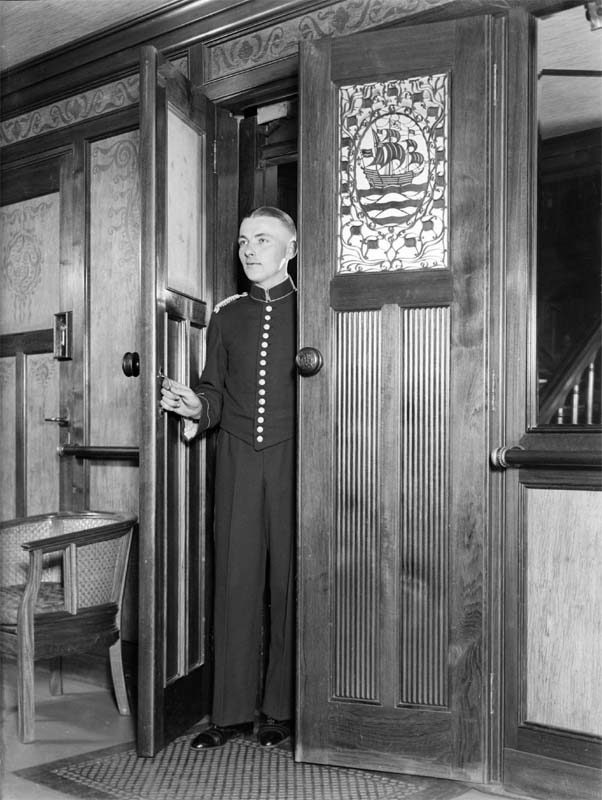
The ships Elevator
(Lift)
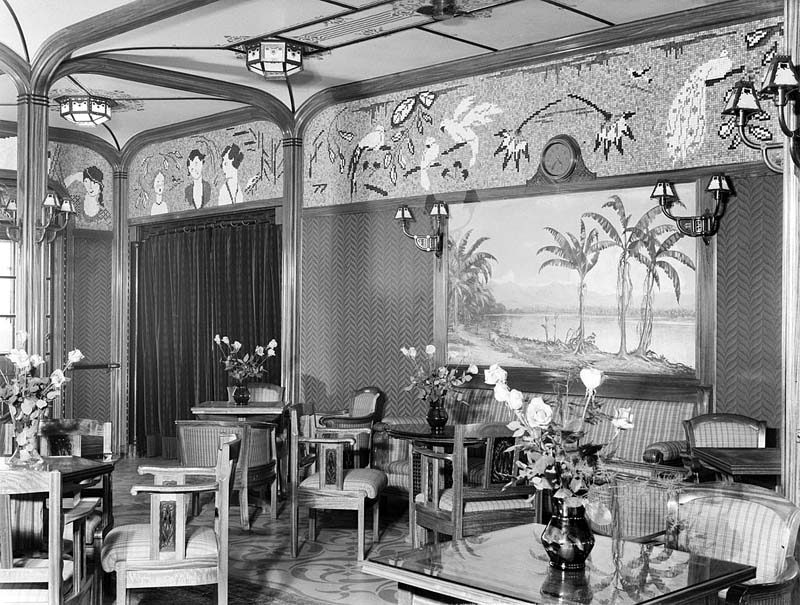
The Music Room
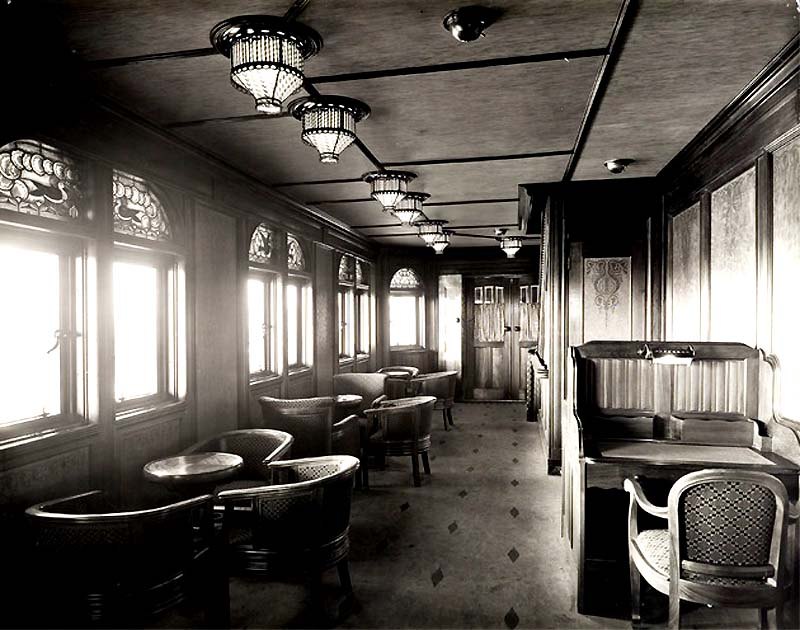
Gallery Reading
and Writing Room with the entrance of the Smoke Room at the end
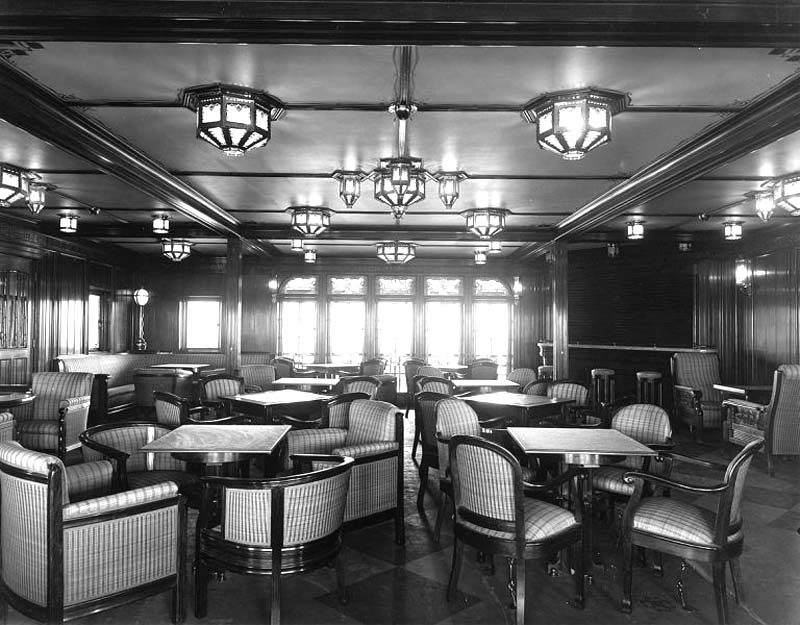
Above &
below: the Salon and Bar
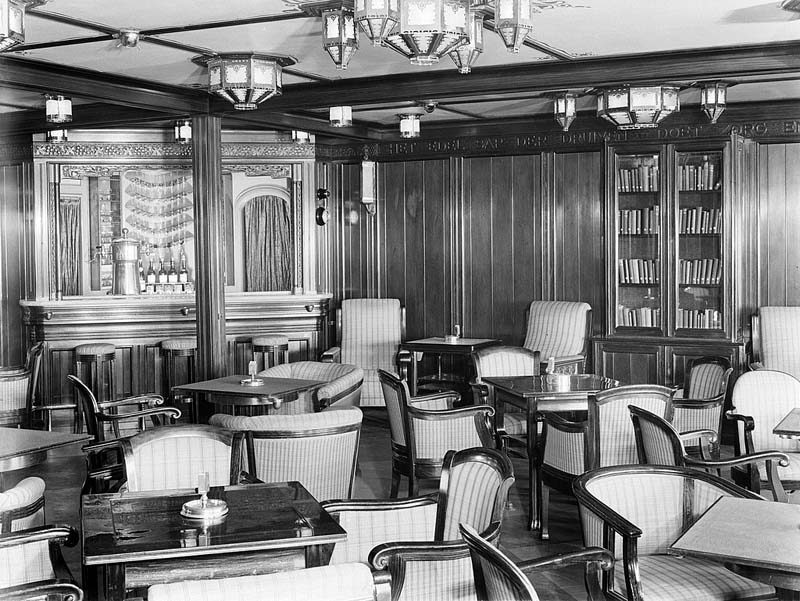
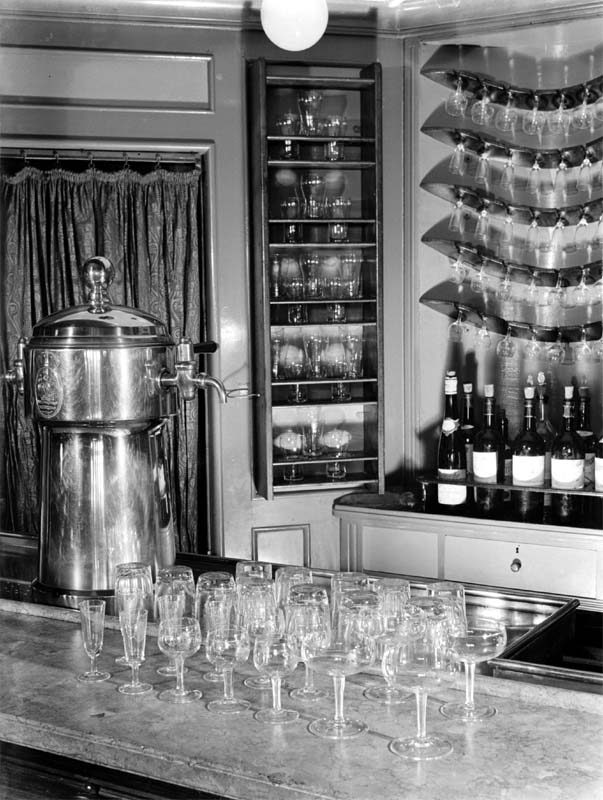
Close up of the
Salon Bar seen in the photo above
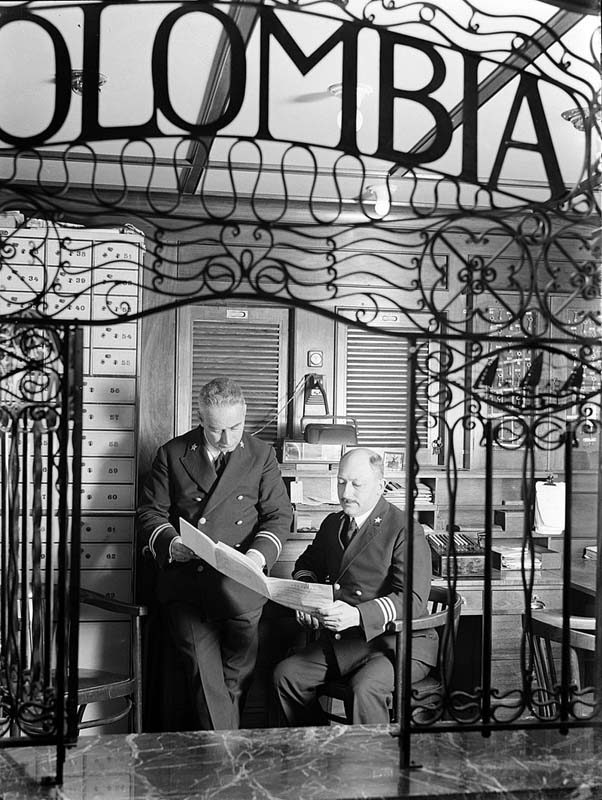
The Pursers Office
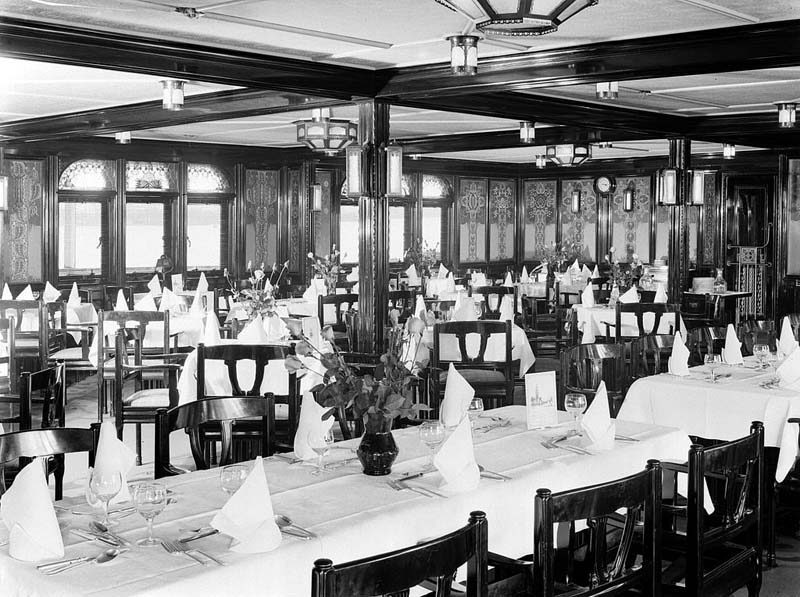
Above &
below: The Dining Room
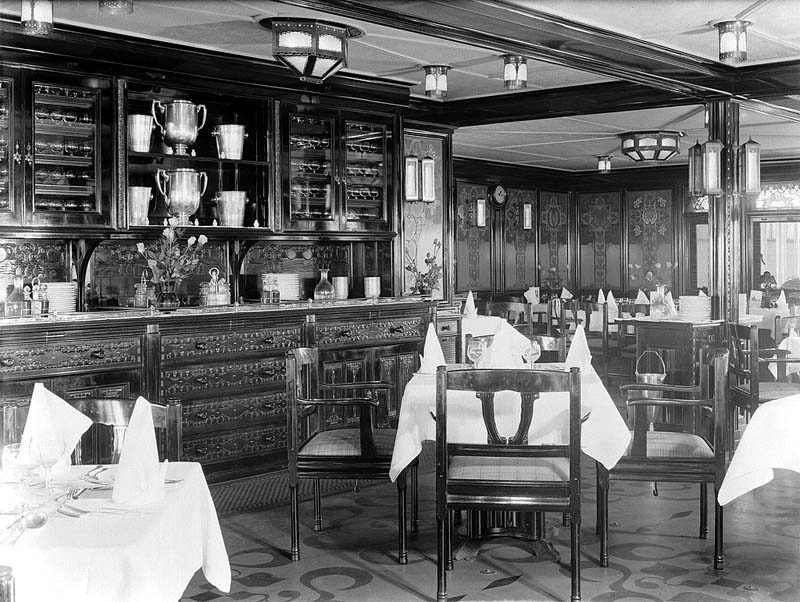
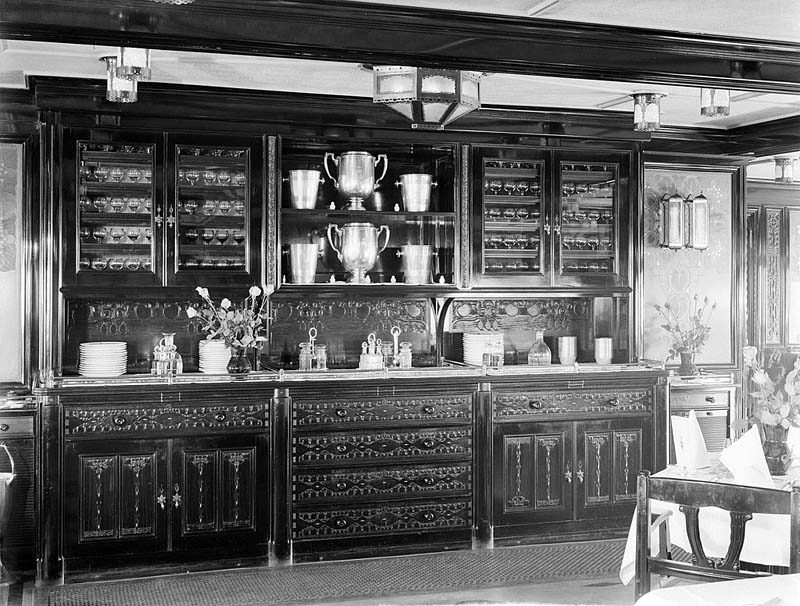
A close up of the
magnificent Buffet seen in the photo above this one
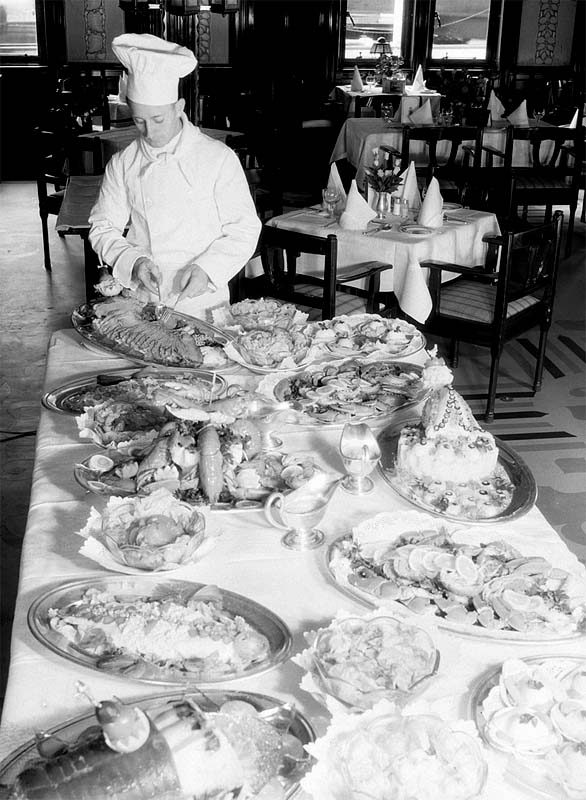
A buffet of the
eating kind on the Colombia
offered the very best cuisine at sea
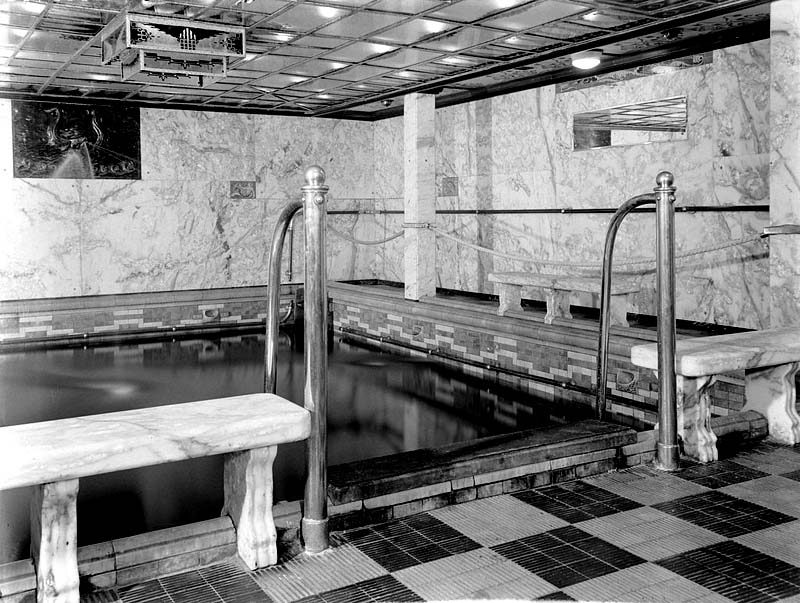
Indoor Swimming
Pool
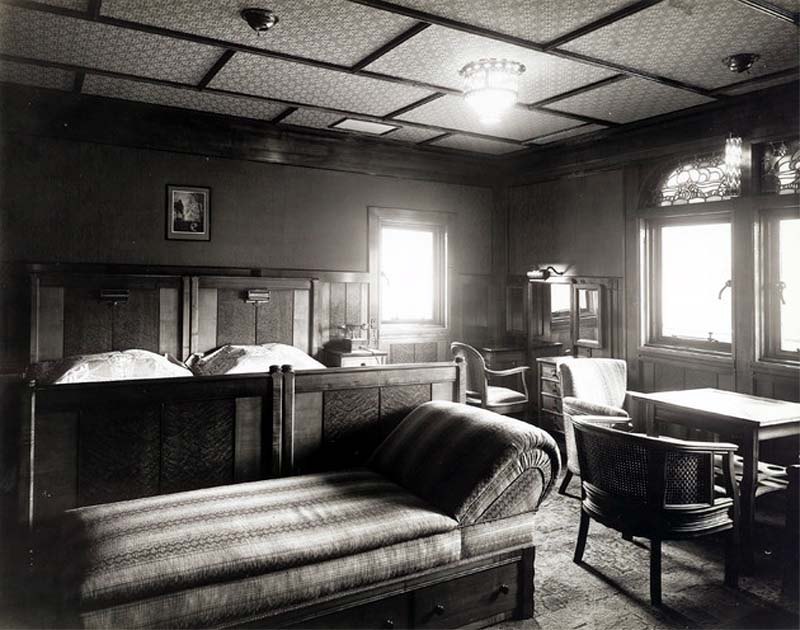
A spacious Suite
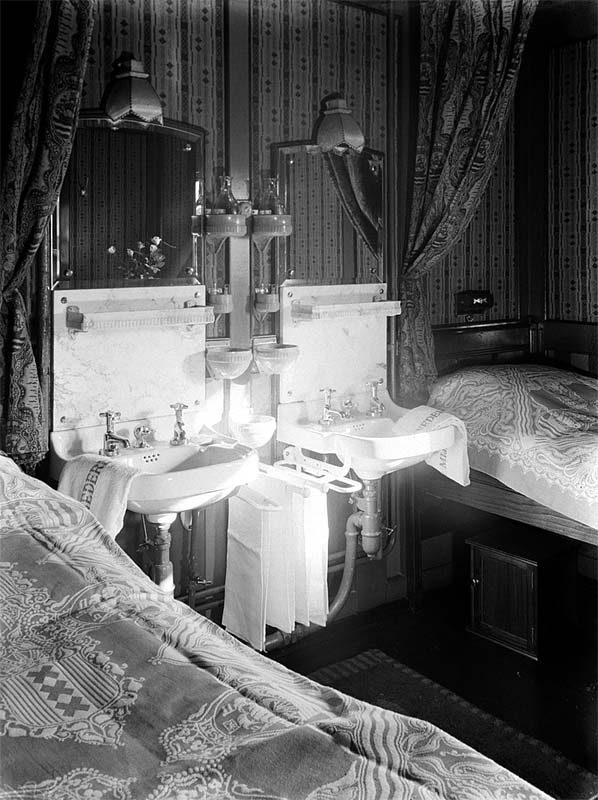
A twin bedded Cabin
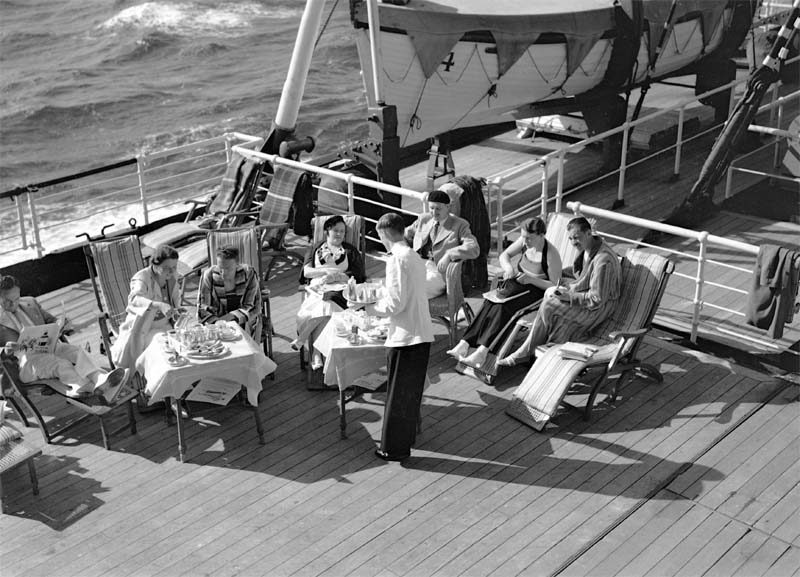
Afternoon Tea out
on Deck
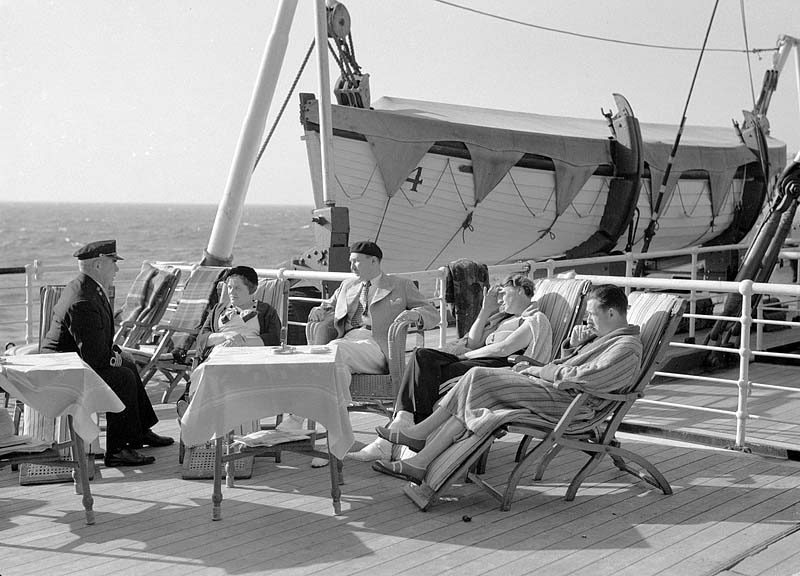
Captain Klok
chats with the Passengers
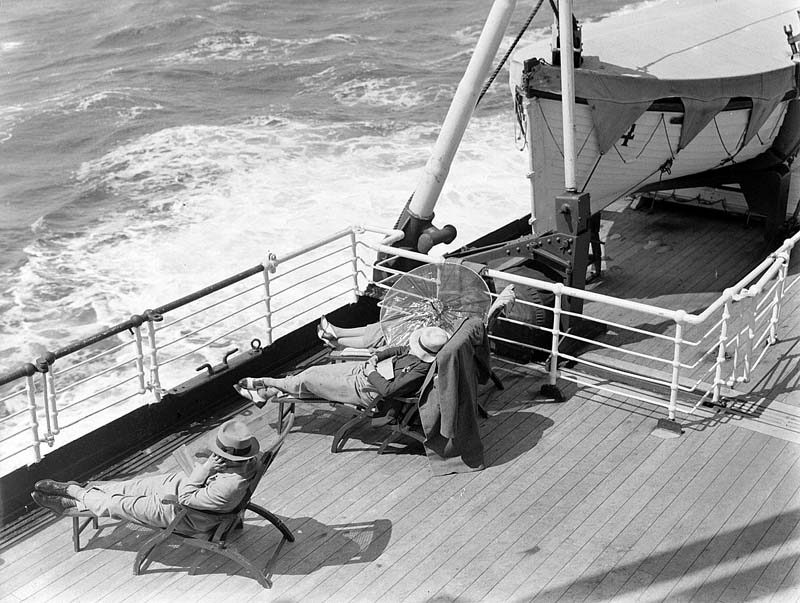
Relaxing at sea
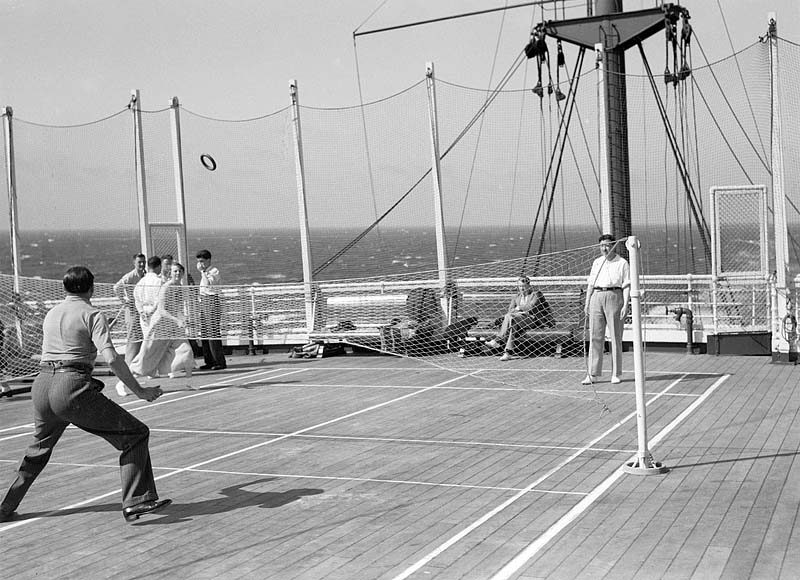
Playing sport up
on Sports Deck aft
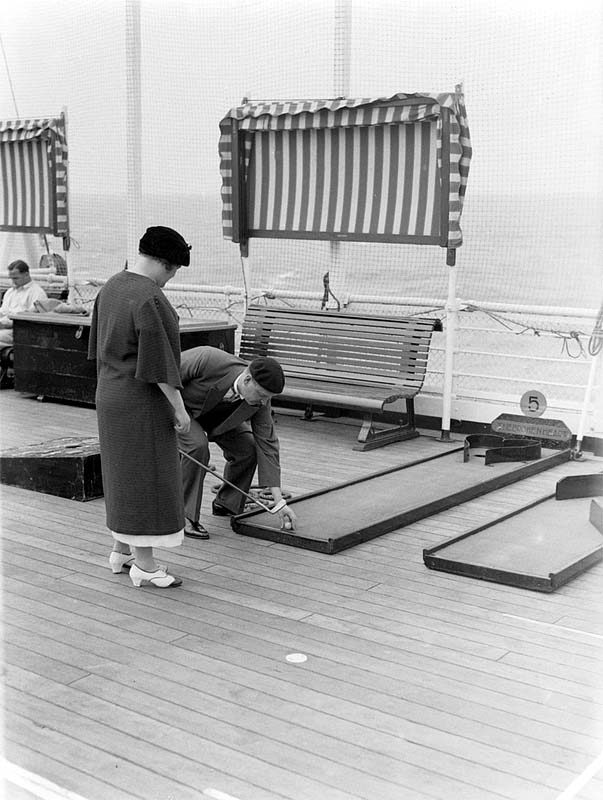
Even a simple
version of golf was available on the Colombia
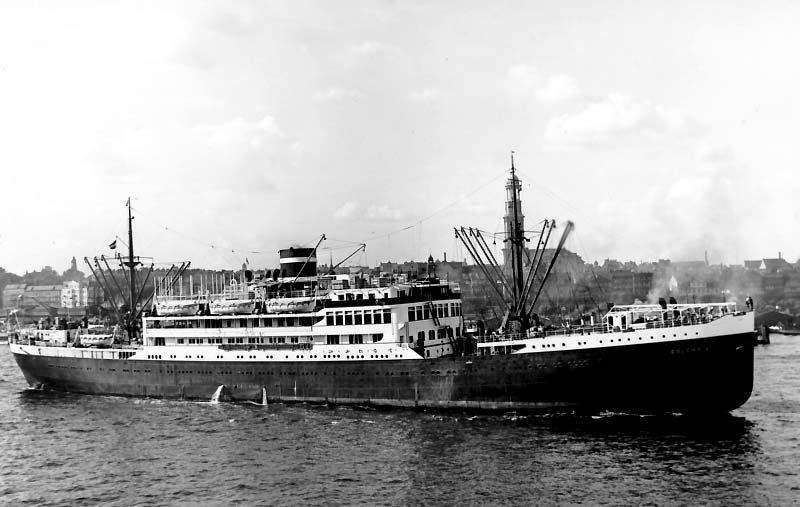
The M.S Colombia
is seen on her starboard side as she arrives back to Amsterdam
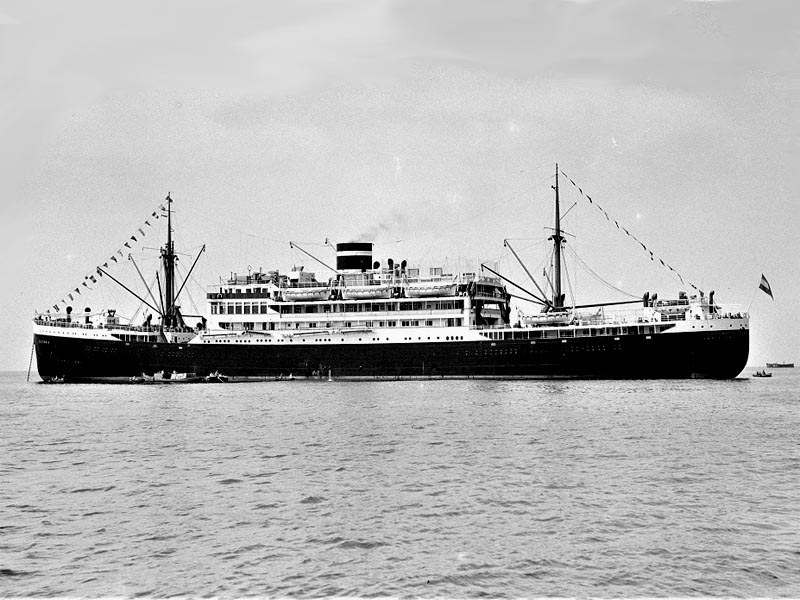
Above &
below: Here we see two views of M.S. Colombia at
anchor at Funchal,
Madeira in
January 1934
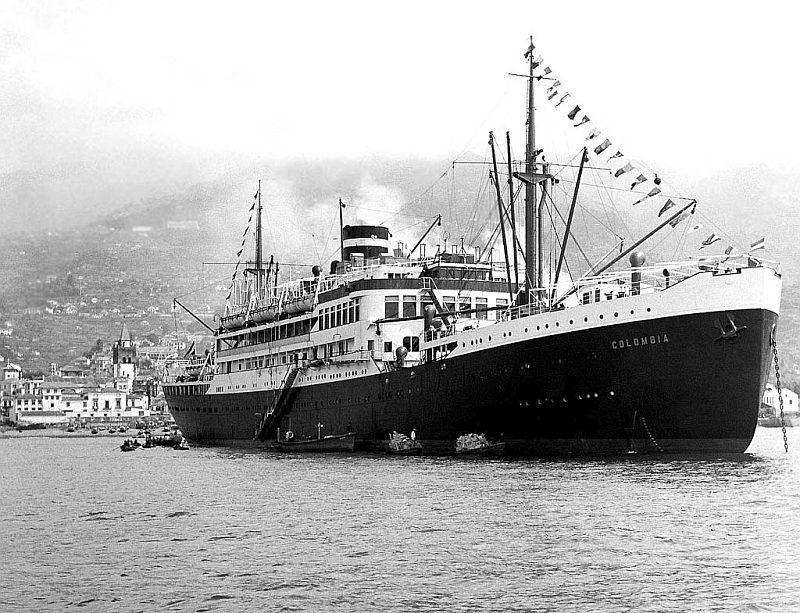
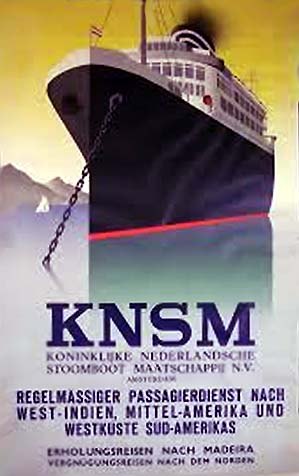
Another KNSM
promotional poster
Second Class
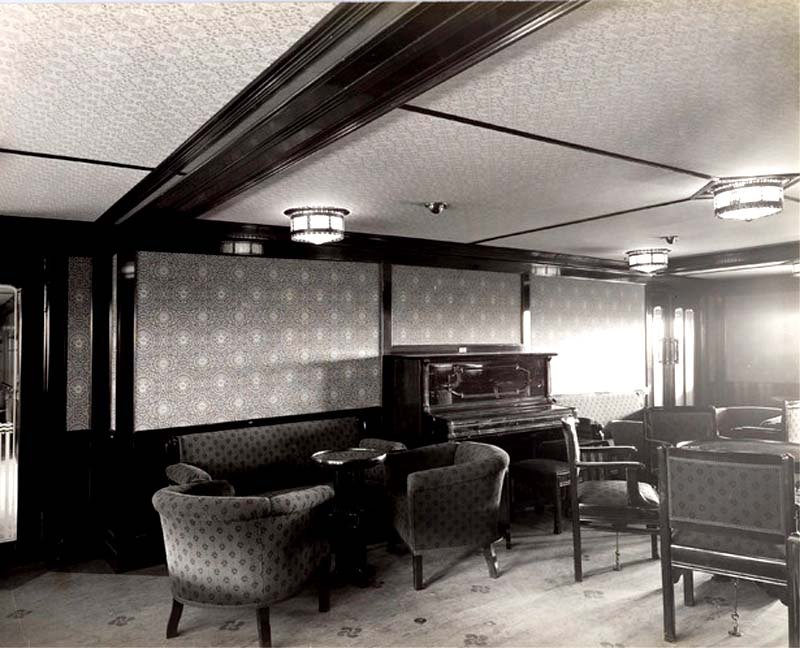
The Music Salon
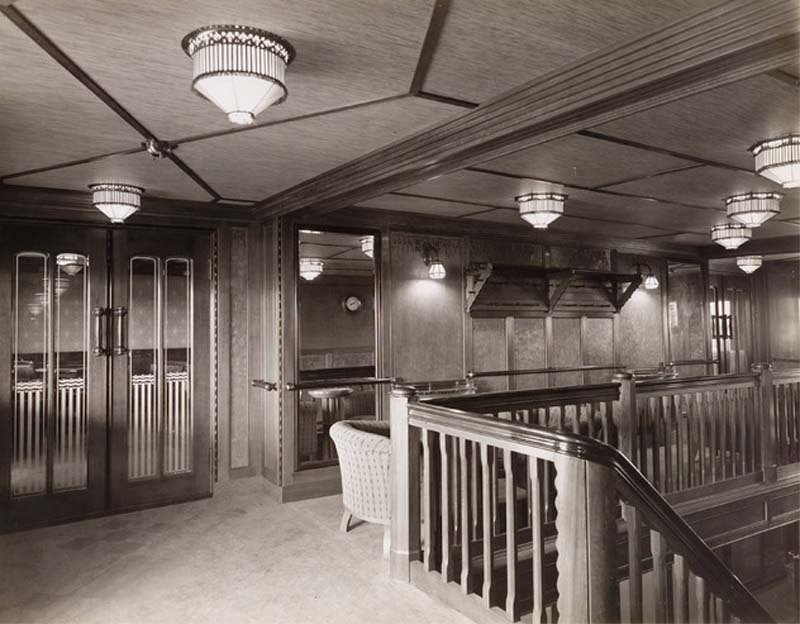
Lobby with doors
to the Smoke room
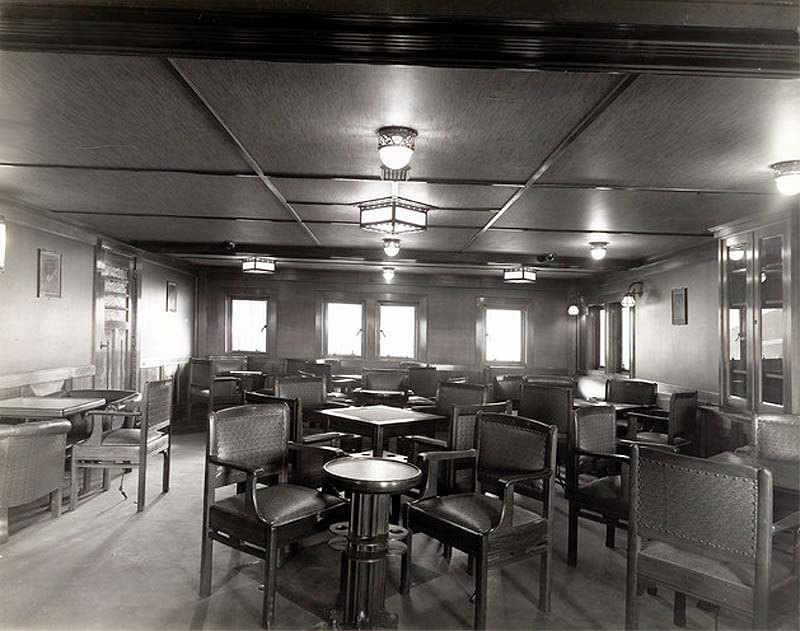
The Smoke Room
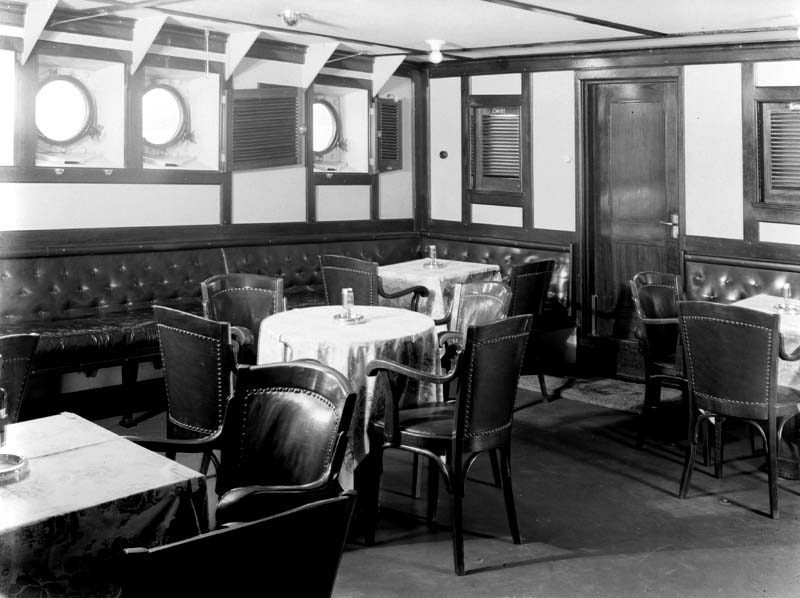
Above &
below: This Lounge also contains a Reading
and Writing section and is located next to the Dining room
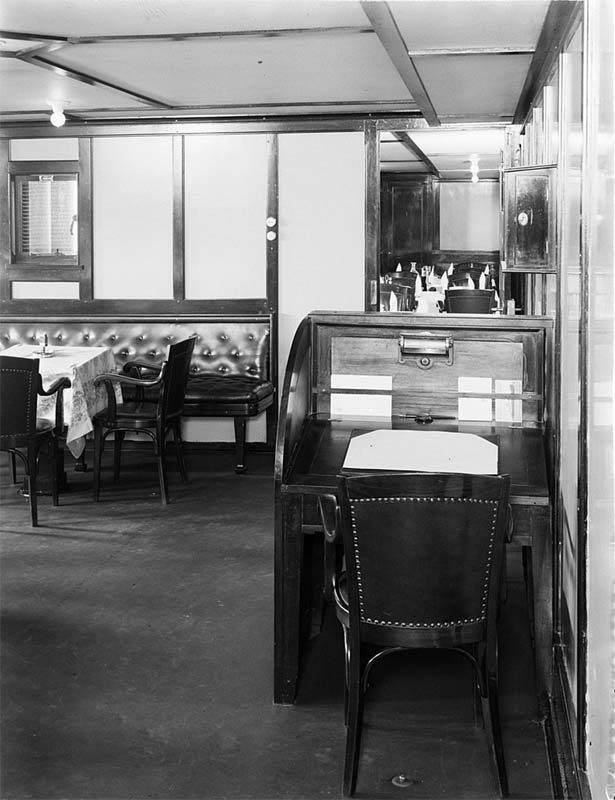
Note the Dining
Room on the top right
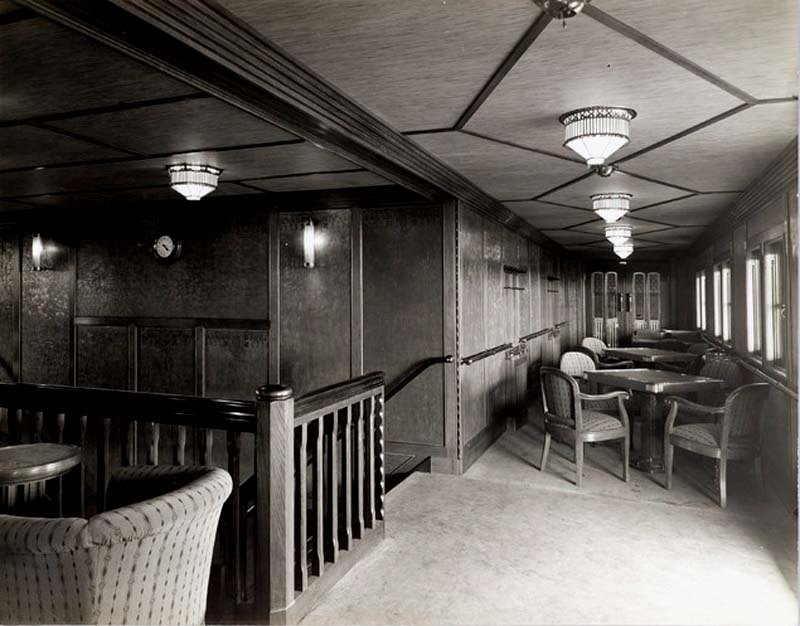
The Lobby leading
to the Dining Room
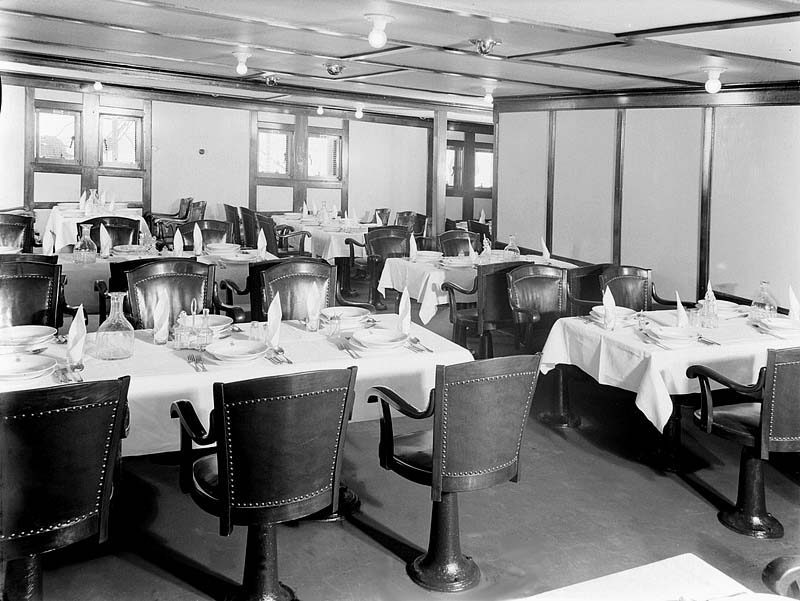
Above &
below: the Dining Room had fixed seating that
swivelled

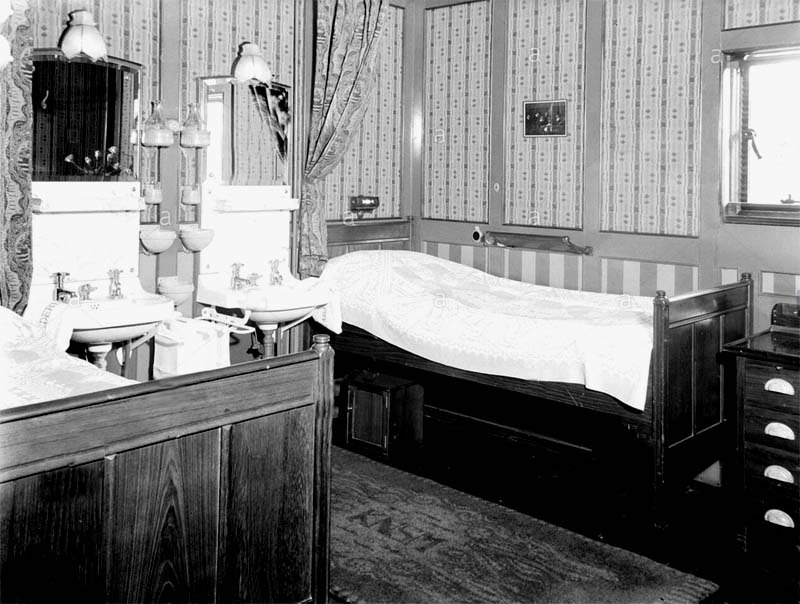
Highest grade
Second Class Twin Bedded Cabin
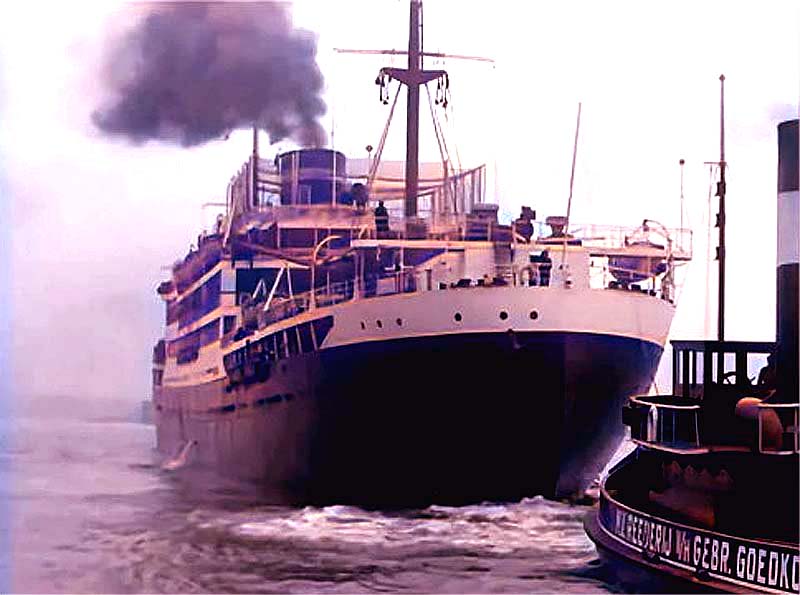
The M.S. Colombia
is seen departing Amsterdam
in a rare colour photograph
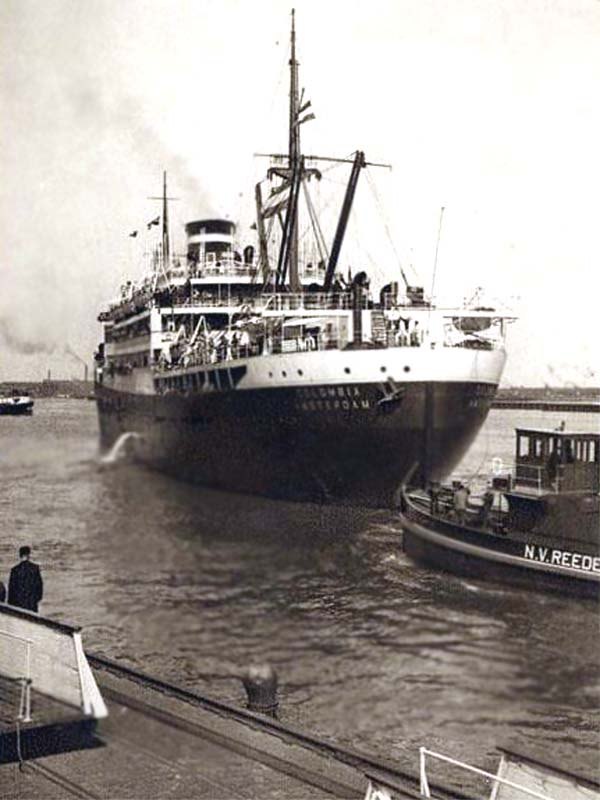
Another
stern view as the M.S.
Colombia
is seen departing Amsterdam
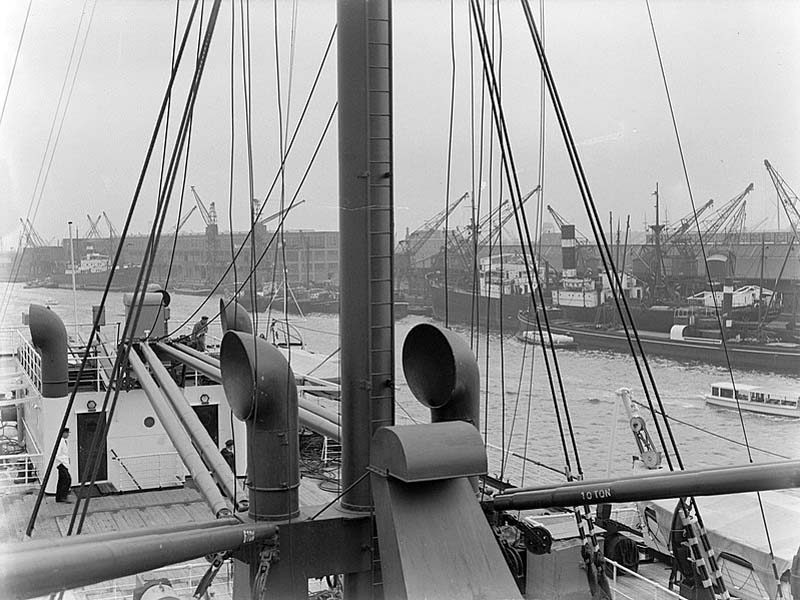
Overlooking her
aft decks
*************************
M.S.
Colombia the Cruise Ship:
The Colombia
during her days frequently operated seasonal cruises to Scandinavia, which were very
popular, this was done whilst she had her usual black hull but also she was
painted with a grey hull for a short time during one of her cruise seasons as
can be seen below.
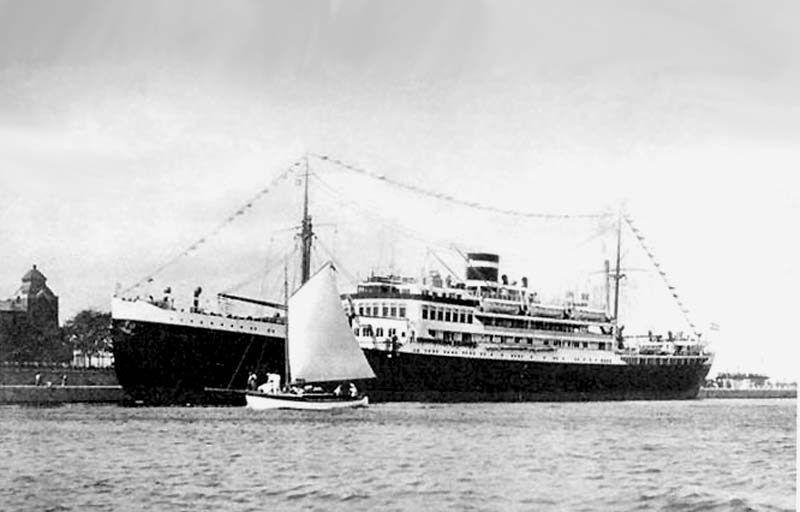
M.S. Colombia is
seen at Copenhagen
during one of her cruises
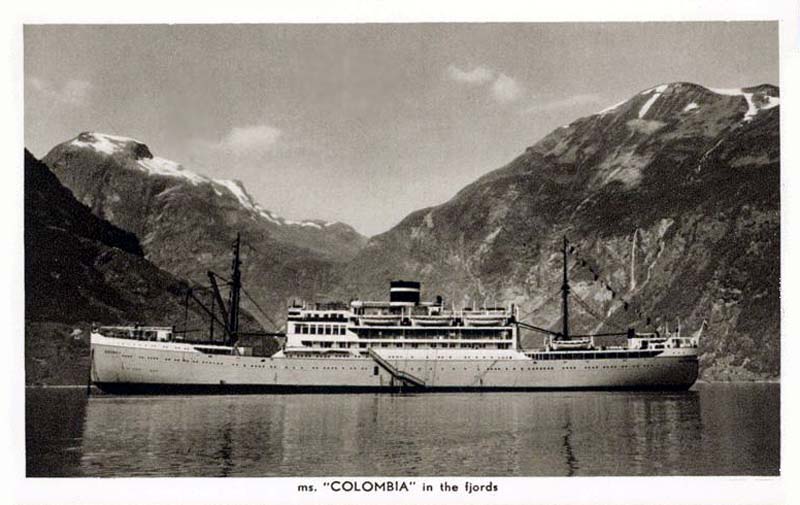
A postcard of the
cruise ship M.S.
Colombia
seen in one of the Scandinavian Fjords
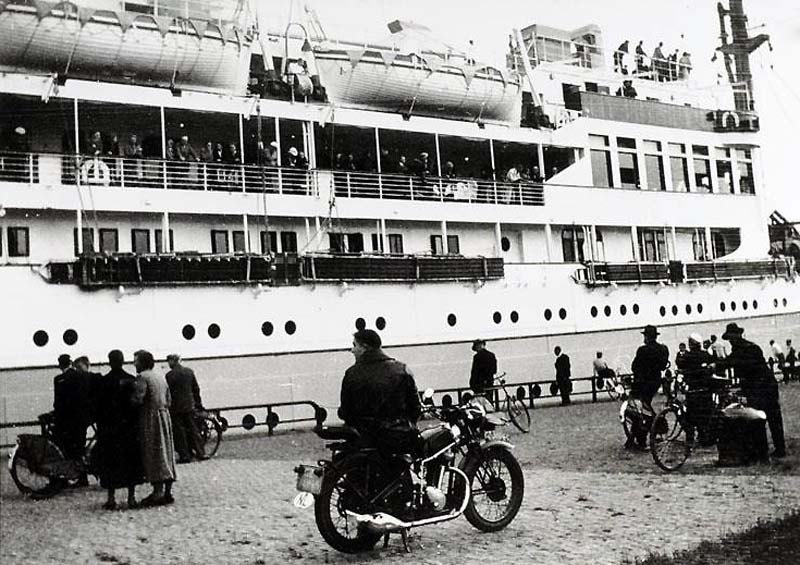
She passes through
the Ijmuiden
locks, the first of which was completed in 1876
Ijmuiden means “Ij mouth”, as Amsterdam
has the River “Ij”
However, with Germany
having invaded Poland
and the war having started the Colombia
was repainted with a black hull again and as the Netherlands
was a neutral country, the Dutch flag and “Holland”
was painted boldly on both sides of her hull, proving the ships neutrality.
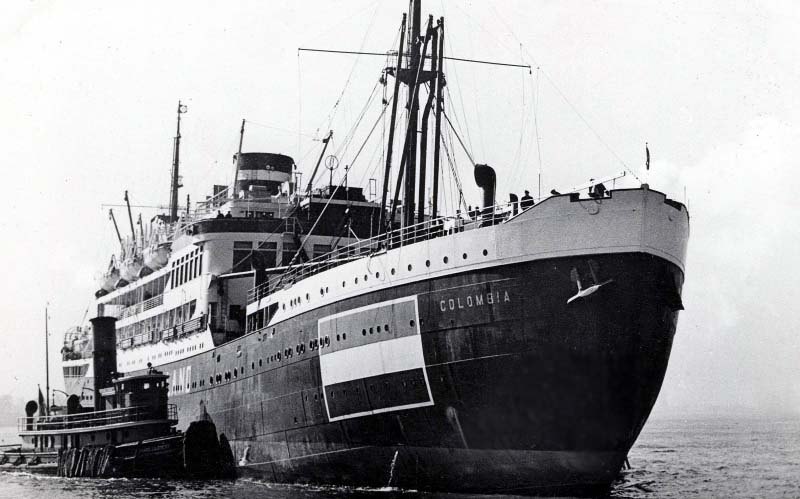
M.S. Colombia with
her special markings before the Nazis invaded the Netherlands
M.S
Colombia a WW2 Submarine Mother-Ship:
M.S. Colombia was requisitioned by
the Royal Dutch Navy on November 8, 1940, for a special
role, which was to become a submarine mother-ship. Her
conversion from a passenger ship to submarine mother-ship was undertaken
in Dundee,
Scotland.
The Colombia
arrived in Glasgow,
Scotland,
from Amsterdam
in January 1941, where she remained until she was placed at anchor on the
“Firth of Tay” just off Dundee
on March 12. She then headed to the yard of the “Caledon Shipbuilding
& Engineering Company”. In the past, this yard had only built
cargo ships, however since the outbreak of WW2, they also carried out
maintenance and repair work for the Royal Navy, mainly on submarines and
other small warships. Initially it was intended that the Colombia
would undergo a limited conversion into an accommodation ship, but at the
insistence of the British Admiralty it was decided to convert her
into a fully-fledged Submarine Mother-Ship, and she was painted in a war
grey. Work on her officially commenced on May 1, 1941 and she was
completed on September 18, and she then became known as the
“Hr.Ms. Colombia”
and she was placed under the command of Captain
Cornelis Hellingman DSO, RNN who served on her from May 1, 1941 to August 18,
1941. He was followed by Captain Lieutenant John
Louis
Karel Hoeke
Cdr RNN
from August 18, 1941 to February 27, 1943.
She was fitted with the following armaments.
Two 7.5cm guns came from the Dutch mine-layer Hr.Ms.
Douwe
Aukes,
and two British-made guns of the same kind were placed at her the stern.
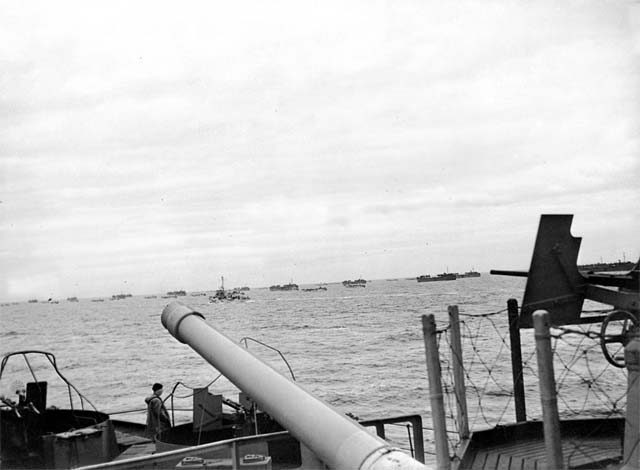
The 7.5cm gun from
the Hr.Ms.
Douwe
Aukes
was fitted to the Colombia’s
bow section
In addition an anti-aircraft battery was set
up on the tent deck, consisting of eight 20mm Oerlikon, six 12.7mm and four
7.7mm machine guns. All of which were connected to a telephone network that
could be operated centrally by the “fire leader”, for whom shelter
was provided behind the gauge compass on the bridge. There was also an
installation was installed on the barge for carrying two paravanes, being
torpedo-shaped floats to which mine sweeping cables could be attached.
On the aft pit deck, lifting seats were
installed on both the starboard and port side for the fast communication and
auxiliary motor boats Hr.Ms. M 73 and Hr.Ms. M 74 that came from “de Mok
air base” located on the Dutch
Island
of Texel. These
boats had been built in 1938 as aircraft assistance vessels for the Naval
Aviation Service (MLD), had escaped to Englandearly
in May 1940 and ended up with the Submarine Service in Portsmouth. After
the relocation of the Submarine Service to Dundee,
the boats followed by land, transported on trucks. On board the Colombia,
the M 73 and M 74 would once again perform their duties as communication boats.
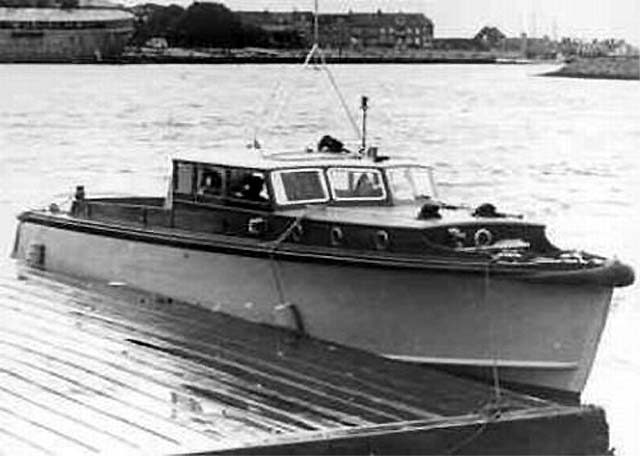
This is the
Hr.Ms. M 73
In addition to the original living quarters
for the crew, the Third Class passenger compartment was intended for troops and
corporals. Room I was converted into a cafeteria and room II into a sleeping
accommodation. The Second Class passenger compartment was predestined for
the non-commissioned officers and thus this section hardly needed any
adjustments. The Second Class Smoking Room functioned as a long room for
the ten midshipmen who would follow the practical part of their training on the
ship. The spacious Music Salon became the long room for the officers and
the staff office was housed in the First Class Smoking Salon. Space III was
converted into a torpedo workshop and in order to be able to make high pressure
air for the torpedoes, the space was equipped with a Junkers
compressor. The reserve torpedoes were stored in the lower hold, with a
separate room amidships for the explosive torpedo warheads. The machine
shop was housed in aft hold N°
IV and this space
was equipped with lathes and other mechanical tools. Furthermore, some First
Class cabins were converted into office spaces and the infirmary was enlarged
to three times its original size. Finally, the Colombia
was equipped with a distiller to supply the batteries of the submarines with
distilled water, and the necessary piping was laid to supply the submarines
with diesel oil as well as drinking water.
However it should be noted that due to the Colombia
having few watertight compartments and the fact that only wood was used for the
entire conversion into a submarine mother-ship, sadly this did mean that the
Hr.Ms. Colombia was a very vulnerable warship from the moment she headed
into war zone.
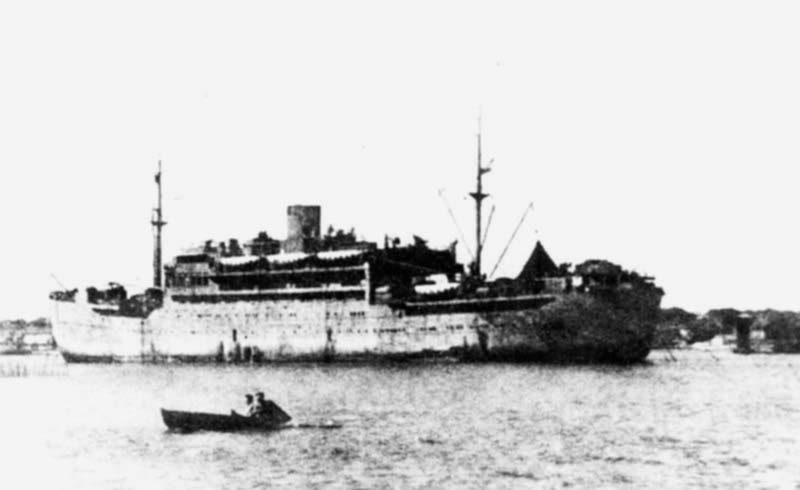
Above &
below: The Hr.Ms. Colombia the submarine
mother-ship with canons showing at her bow and stern
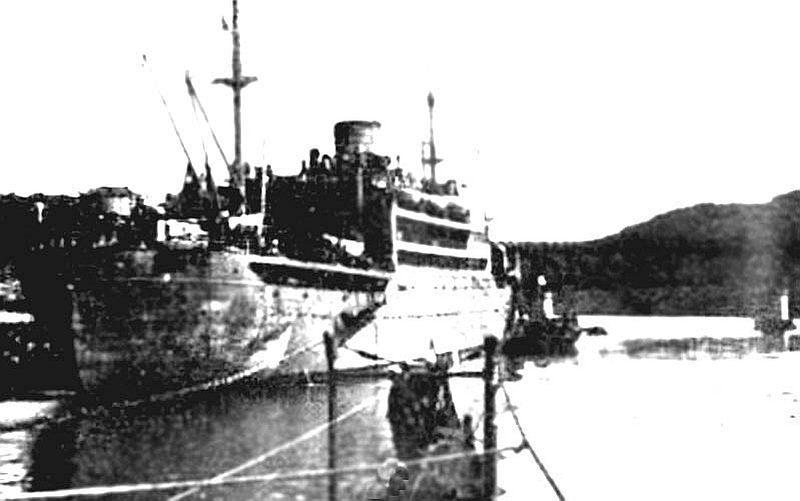
On January 5, 1942, Hr.Ms. Colombia
departed Dundee and she sailed in convoy WS 15 which was bound for
the Dutch East Indies (today’s Indonesia).
But, as the Japanese had taken the Dutch East Indies during Colombia’s
voyage there the Navy rapidly decided to redirect her and
station her in Colombo,
Ceylon
(today’s Sri
Lanka).The
convoy arrived at Colombo
on March 4, 1942.
In addition three Dutch submarines,
the K XIV, K XI and the O 19 & the O 23 had now also
headed to Colombo
as they required maintenance to be carried out in nearby
Bombay, India. Thus
the Colombia
remained at Colombo
until May 13, 1942, when she headed for Bombay,
yet she would only remain there for
three months. For in August 1942 she headed to East London where
she arrived on August 24, at 08:35 hrs and she served as a mother-ship
supporting Dutch submarines operating to and from the Far East.
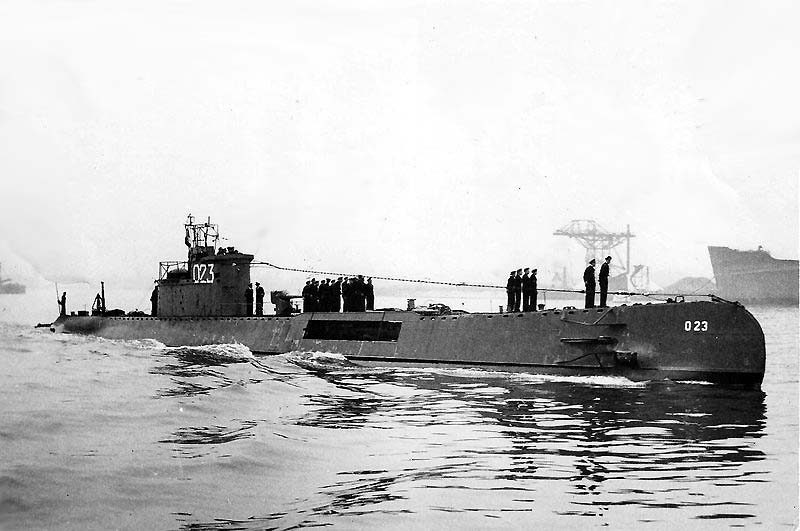
Above we see one
of the Dutch submarines, the Mr.Ms. O 23
Due to a large part of the
British Eastern Fleet being stationed in Kilidini, Kenya,
and there was a shortage of mother-ships in the Eastern Fleet, thus
the submarine mother-ship Hr.Ms. Colombia
was transferred to Africa. Yet
she was not stationed in Kilidini, but in East London, South Africa. Here
the ship supported submarines bound for the Asia as well as the United Kingdom and
the United States. Local
war ships were also supported.
On September 17, 1942, the Colombia
received an unusual request from one of the officers of the Indian
minesweeper the HMIS Orissa, and the request was if the Colombia
would take over the Orissa and place it under Dutch command. The
reason for the Orissa takeover was that a violent mutiny had broken
out on the ship, which happened after news arrived from India
that Gandhi had
been arrested by the British. Thus a landing division consisting of 18 men
from the Colombia and
10 men from the Nigella managed to capture the ship, and thankfully they did so
without too much opposition and her crew was brought back into line.
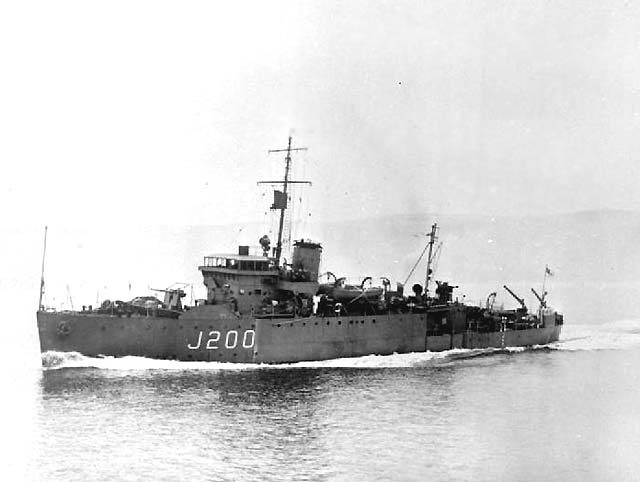
HMIS Orissa was a “Bangor
class” minesweeper
The
Hr.Ms. Colombia’s
Tragic End:
At the request of Admiral Helfrich,
the Hr.Ms. Colombia would return to Colombo,
but she first had to head to Simon's
Town, South Africa as
she required maintenance which meant she needed to be dry-docked there.
On February 27, 1943, the
Hr.Ms. Colombia with a complement of 318 on board was sailing on the
Indian Ocean sailing from East London
and heading for Simon's
Town, she was being escorted by the HMS Genista and several RAF
aircraft. However, not far from Simon's
Town was the German U-Boat, the “U 516”, which
was under the command of Captain
Gerhard
Wiebe
and as soon as he Colombia came into his sights he commenced to fire a
spread of three torpedoes from around 1,500 m distance. Four minutes later at
11:45 am, his last torpedo struck the forward section of the Hr.Ms. Colombia on
her starboard side and it hit directly where the N°2 hold was, suddenly a huge
column of water arose beside the ship, while many of her teak deck-planks were
thrown in all directions. Realising the ships situation Captain
John
Louis
Karel
Hoeke,
very quickly announced “Abandon ship, abandon ship” and all
hands rapidly left the ship either per lifeboat or simply jumped overboard. The
Colombia
sadly sank after some ten minutes, at position 33º36'S, 27º29'E, and the last
torpedo had sadly killed eight of those precious lives who happened to be near
the explosion.
I have been told that in one whaleboat there
were some 60 survivors and they were later picked up by a RAF air-sea-rescue
launch. The escorting Genista initially launched a counter-attack, but she
returned soon after and picked up the remaining 250 survivors.
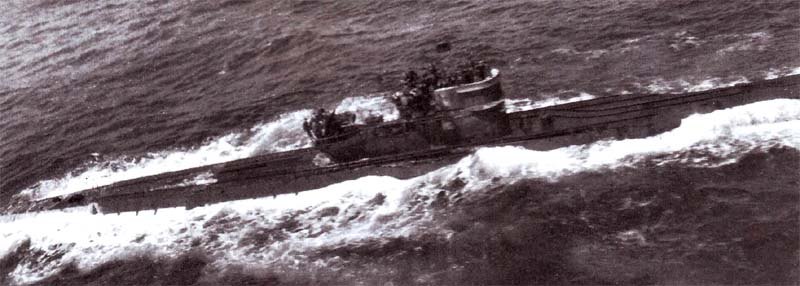
This is
the German U-Boat, the U 516
The Story
of an Amazing Hero:
During the
horrid sinking of the Hr.Ms. Colombia,
sailor Manuel
Avelino had already boarded the portside N°2
lifeboat and it was already away from the ship. However, as he looked back he
noticed that three of the ships lifeboats were stuck in ropes and had not been
launched from the rapidly sinking ship. Thus
he jumped overboard and his lifeboat commander called for him to come back, to
which Manuel
shouted: “Go ahead, I’ll get off”. He climbed back on board the Colombia
that was still above the waves and made sure that the three lifeboats were
released and in the water and took on more lives that were now saved thanks to
his amazing heroic act. Amazingly
it was only seconds before the Colombia disappeared under the waves forever,
that Manuel jumped into the sea from the stern of the ship that had risen high
up, and he had to swim between the rudder and those still rotating propellers,
yet he miraculously managed to get away from disaster and reach one of the
lifeboats. Thanks to his
remarkable actions, the number of victims of Wiebe’s evil torpedo attack
were thankfully limited to eight souls that died in the blast, but all others
on board managed to be saved!
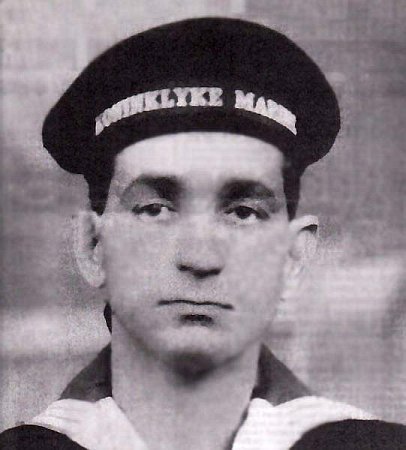
The Heroic sailor Manuel
Avelino
The
survivors of the Colombia
were later taken to England
on the famous R.M.S. Queen Mary,
as a troopship during the war she was known as the “Grey
Ghost”.
It was on
May 6, 1943, that
Manuel
Avelino
was nominated by HRH
Queen Wilhelmina
of the Netherlands,
and he was honoured with the “Cross of Merit” for courageous, competent and decisive
action. The Portuguese born
sailor who was in the Dutch service sailed for the rest of the war on other
KNSM ships on which he brought, among other things, allied troops to Sicily. He was not reunited with his beloved wife and
children until the summer of
1945. It was two years later, in 1947 that
the Portuguese Cape Verde-born sailor was naturalized as a Dutch citizen. However, on March 23, 1953, Manuel
Avelino
was also awarded the most important of war awards the “War Remembrance
Cross”. Sadly, Manuel
Avelino passed away on June 8, 1980, at the age of 81 in Brielle, the Netherlands.
For a full list of all those on board the
Hr.Ms. Colombia at This LINK.
*************************
M.S. Colombia Specifications &
Details:
Manager
& owner: “Koninklijke
Nederlandsche Stoomboot-Maatschappij NV”, Amsterdam,
Netherlands.
Home
Port: Amsterdam,
the Netherlands.
Type: Passenger-Cargo
Ship.
Call
sign: NKPD.
. PDLA
after 1933.
Built by: “P.
Smit
Jr”
Shipyards, Rotterdam.
Ship
ordered: April 16, 1929.
Keel
laid: 1930.
Yard N°: 454.
Material: Steel.
Deck
Type: Open Shelter Deck.
Decks: 5.
Holds: 4.
Launched: May 24, 1930, she was named
and launched by Mrs. M.E. Giljam-Irens.
Sea
Trials: October 17, 1930.
Delivered: October 22, 1930 to the KNSM
Maiden Voyage: November 28, 1930.
GRT: 10,782 GRT, NRT:
6,336 NRT, 6,643 DWT.
Length: 130.9 meters overall.
Beam: 18.82 meters on the
frames.
Draft: 8.1 meters
(Summer) .
Passengers: 312 persons.
. 180
First Class, 66 Second Class & 66 Third Class.
Crew: 148.
Propulsion: Two 4 stroke single acting
Werkspoor engines.
Type: 4t., Ew. 8,000
HP, MOT at 110 rpm.
Propellers: 2.
Speed: 15.5 knots.
Fate: Torpedoed on February
27, 1943 by U-Boat 516 and was hit to the starboard near hold 2. The ship
vertical, the stern high in the air, rudder and propellers protruded 25 meters
above the water. At 11:55 am the Colombia
sank below sea level in loss of 33° 36'S, 27° 29'E.
*************************
The ssMaritime KNSM Index
Also visit the
KNSM S.S. Cottica 1927 to 1958
The
KNSM 1930 Flagship M.S. Colombia
Also view the
YouTube Colourised Video of the M.S. Colombia
Crossing
the North Sea on the luxury liner M.S. Colombia from Amsterdam
to Dover
As well as 35 excellent KNSM-Passenger-Freighters
And the magnificent KNSM
ships M.S. Oranje Nassau & Prins Der Nederlanden of 1957
*************************
Remembering
the Delightful KNSM Flagship - M.S.
Colombia
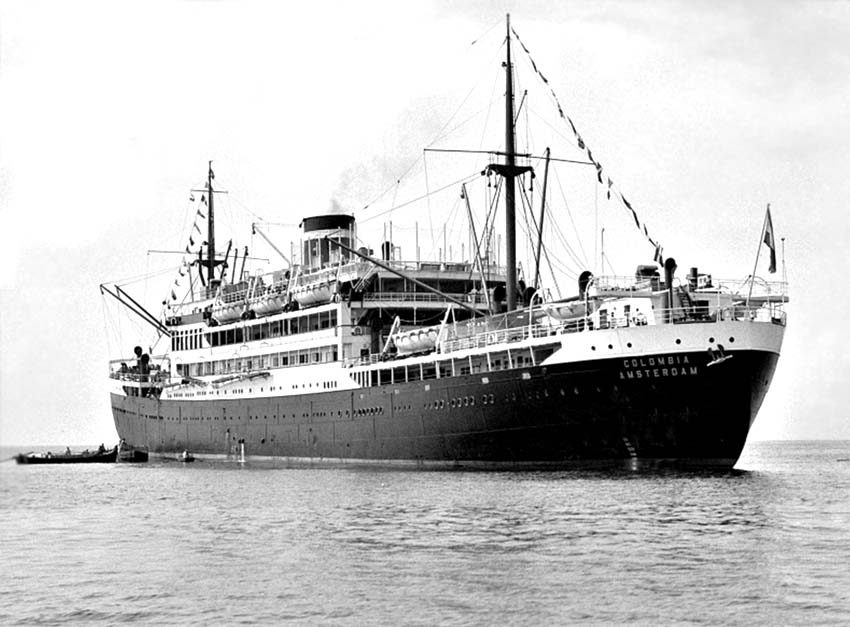
A stern view of
the M.S. Colombia
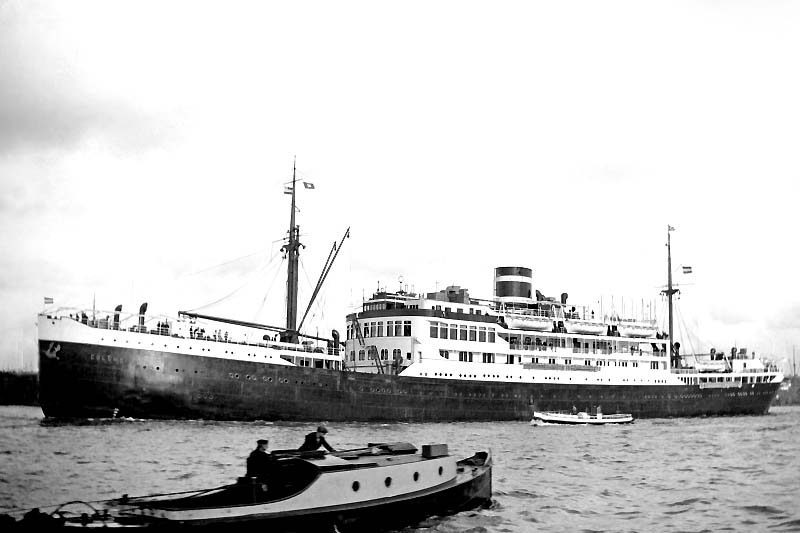
M.S. Colombia is seen
departing Amsterdam
Harbour
“Blue Water Liners sailing to the
distant shores.
I watched them come, I watched them go and I watched them
die.”

Featuring over 1,358
Classic Passenger Liners, Passenger-Cargo Liners & Classic Cruise Ships!
Or ENTER HERE
For interest:
Sadly an email service to ssMaritime is no longer available, due to the
author’s old age and chronic illness as well as being disabled, etc. In
the past ssMaritime received well over 120 emails per day, but Mr.
Goossens
can no longer handle same. He sincerely regrets this!
**************************
ssMaritime.com & ssMaritime.net
Where the ships of
the past make history &
the 1914 built M.S. Doulos Story.
The Author has
been in Passenger Shipping & the Cruise Industry for well over 60 years
In addition he was
the founder of “Save the Classic Liners Campaign” in 1990.
Please
Note: ssmaritime
and associated sites are 100% non-commercial and the author seeks no
funding or favours of any shape or form, never have and never will!
Photographs on ssmaritime and associate
pages are by; the author or from the author’s private collection. In
addition there are some images that have been provided by Shipping Companies
and private photographers or collectors. Credit is given to all contributors.
However, there are some photographs provided to me without details regarding
the photographer/owner concerned.
This notice covers all pages; although, and I have done my best to ensure that all
photographs are duly credited and that this notice is displaced on each page,
that is, when a page is updated!
ssMaritime is
owned & © Copyright by Reuben Goossens -
All Rights Reserved





 -
-




















































